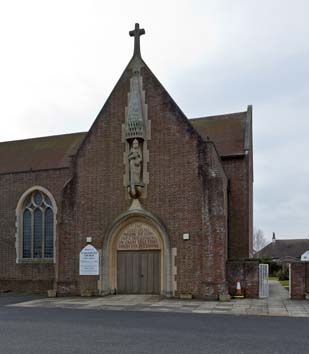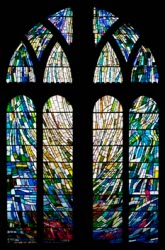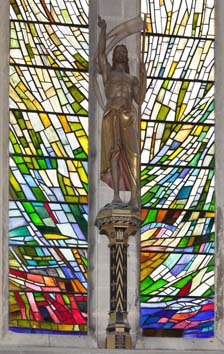Bexhill – St Augustine, Cooden
W H R Blacking made plans for a church amid the developing bungalows of Cooden in 1931 (CDG Sept 1931 p371). The first part, consisting of the chancel and the two east bays of the nave, was consecrated in 1934 and cost £7300 (ibid May 1934 p222). The material is brick and nave and aisles are of the same height. The windows have a simplified form of Perp tracery of the kind favoured in the early C17 and the chancel is similar. As befits a pupil of Sir J N Comper, Blacking combined a gothic exterior with late C17 detail inside – there is no chancel arch and the broad, round-headed arches of the plain arcades would not be out of place in a church of Wren’s era; the vaulted roof with its pendants above the arcades would not be out of place either. The aisle roofs are panelled. All is white, so that despite the absence of a clerestory the whole church is light.
Blacking planned a further three bays of the nave and a north west tower (VCH 9 p122), but when construction was resumed in 1960 it was to a revised design by H H Ford (BE(E) p119) which was completed in 1963. He added only two more bays, resembling the earlier ones, with a west gallery. In place of the tower is a large two-storeyed porch with a cross-gable. The tympanum bears an inscription under a large niche, containing a figure of St Augustine by J Skelton (ibid), who was probably also responsible for the adjacent lettering.
Fittings
Font: Octagonal and in the free gothic style of many of the other fittings, all of which are probably by Blacking.
Glass:
1. (East window) M Douglas Thompson, 1979 (www.stainedglassrecords.org, retrieved on 28/1/2013).
2. (South chancel window, two lights) J C N Bewsey 1919, stated to have been brought here from St Thomas, D’Avigdor Road, Hove (ibid), presumably after that ceased to be an Anglican church in 1993.
3. Two north windows, attributed to Sir J N Comper of c1920, are also said to have been brought here from St Thomas (BE(E) ibid), but there is no glass in the church of such a kind and Robert Eberhard (personal communication) suggests that this statement results from confusion with the two known windows by Bewsey from the same source (see above).
My thanks to Nick Wiseman for the photographs







